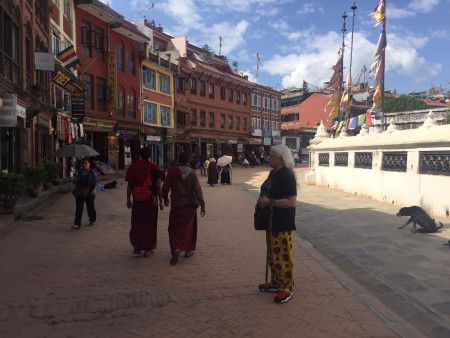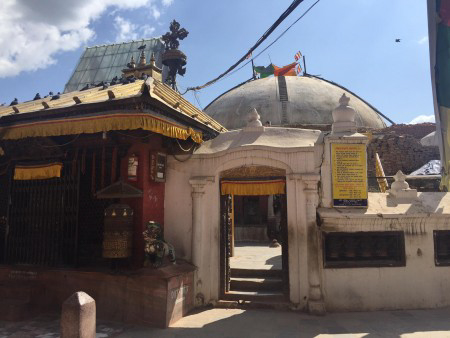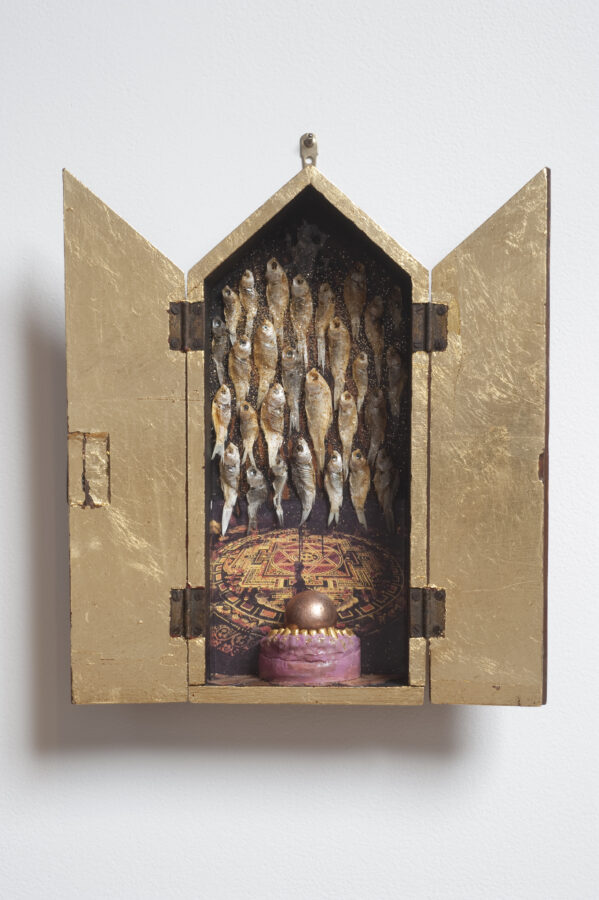


In 2015 the Rubin Museum’s Modern and Contemporary Art Curator Beth Citron traveled to Nepal with the legendary performance artist and musician Genesis Breyer P-Orridge. The trip, in preparation for the 2016 exhibition Genesis Breyer P-Orridge: Try to Altar Everything, didn’t always go as planned. Read Beth’s account of their journey.
I traveled to Nepal with the artist in October 2015. Genesis and I had a few items on our official to-do list, namely the production of psychic crosses and a carpet designed by the artist for the upcoming exhibition. Beyond this, we planned to spend our time exploring Kathmandu and the surrounding Valley. As we planned our trip, we were both sensitive to the devastation and day-to-day impact of the recent earthquake, but unbeknownst to us, Kathmandu was also experiencing a serious fuel crisis; despite the crisis immobilizing the city and surrounding areas, there had been almost no coverage in the international media in the weeks leading up to our trip. The shortage posed a challenge to our plans in terms of the exhibition goals, but also to our daily experience. It was difficult to find taxis to drive us places and restaurants that had enough cooking gas to prepare foods on their menus. There were also frequent power outages at all times of the day. As we navigated the city, we could only think of how deeply we felt for residents of Kathmandu who were now enduring these conditions after the spring earthquake.

After our first few days of sorting out exhibition plans and Kathmandu logistics, we were fortunate to find a taxi that would drive us to Bodnath Stupa, venerated by Kathmandu’s significant Tibetan Buddhist population. The stupa had been badly damaged in the earthquake and the parts above the dome had to be removed, along with the relics inside. It is a significant site in Genesis’s experience in Kathmandu because s/he funded and ran a soup kitchen at Bodnath in collaboration with a local Tibetan monastery over the winter of 1991–1992. During that time, Genesis and h/er family prepared simple food for 300–400 people two times a day, a story s/he recounted to me as we circumambulated the stupa.


Several days later, we found the same taxi driver to take us to Pashupatinath, a sacred temple complex on the banks of the Bagmati River. Many cremations take place at the site, and sadhus, or holy men, pass their time there, asking for alms from tourists and locals. Genesis has an interest and affinity for sadhus and their extreme practices, particularly those of the Aghori Babas who follow the “path of no distinction.” S/he struck up a conversation with one of them (he spoke excellent English), and he explained that he had been the subject of a recent documentary by an American filmmaker. We walked around the peaceful site and were able to watch a few open air cremations. It was a serene experience, with the feeling of being at a sacred site palpable.
After almost two weeks, it was time to return. Production for our exhibition seemed to be on track, quite remarkably given the conditions in Nepal. As I read the news about Nepal now every day, I am grateful for the opportunity to have traveled there for such an extraordinary person and project.

For nearly half a century Genesis Breyer P-Orridge (British, 1950–2020) questioned the meaning and substance of identity through artistic endeavors, willful reincarnation, and physical shapeshifting. Embracing the body as not simply the vessel but the site of the avant-garde impulse, Breyer P-Orridge reinvented and reintroduced h/erself again and again—as Fluxus pioneer, groundbreaking performance artist, inventor of industrial music, “wrecker of civilization,” essayist and theoretician, and with her late wife Lady Jaye as pandrogyne. Breyer P-Orridge’s work has been the subject of numerous international exhibitions, including S/he is Her/e at the Andy Warhol Museum, Pittsburgh (2013), and Life Is A Cheap Suitcase at Summerhall, Edinburgh (2014).

Beth Citron was previously the curator of modern and contemporary art at the Rubin Museum of Art. Her exhibitions for the Rubin Museum included Genesis Breyer P-Orridge: Try to Altar Everything (2016), Francesco Clemente: Inspired by India (2014), Witness at a Crossroads: Photographer Marc Riboud in Asia (2014), and the three-part exhibition series Modernist Art from India (2011-13). She completed a PhD in the History of Art at the University of Pennsylvania, and has taught in the Art History Department at New York University, from which she also earned a BA in Fine Arts.

Rubin Museum
150 W. 17th St., NYC
Get the latest news and stories from the Rubin, plus occasional information on how to support our work.